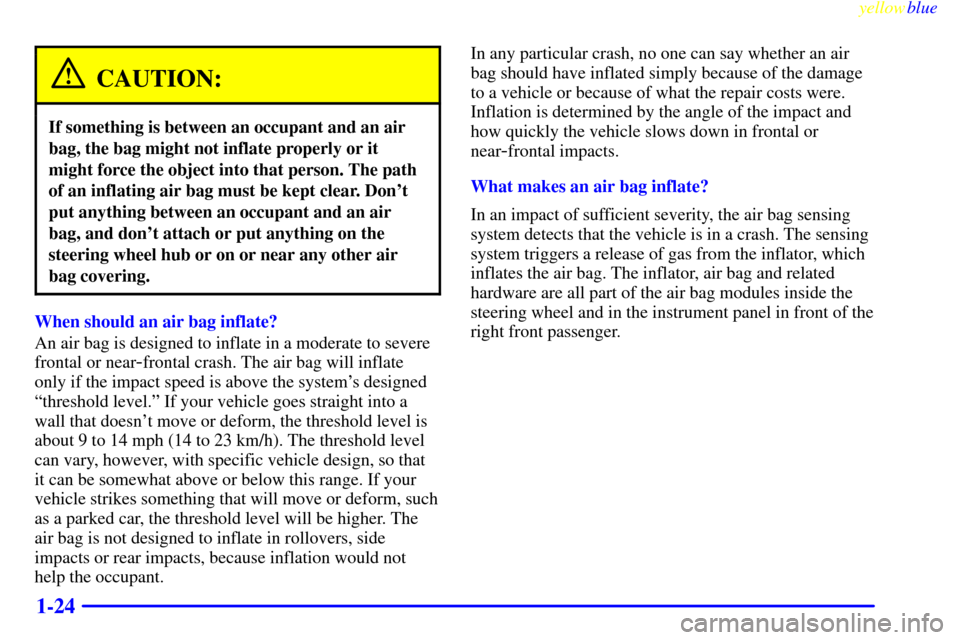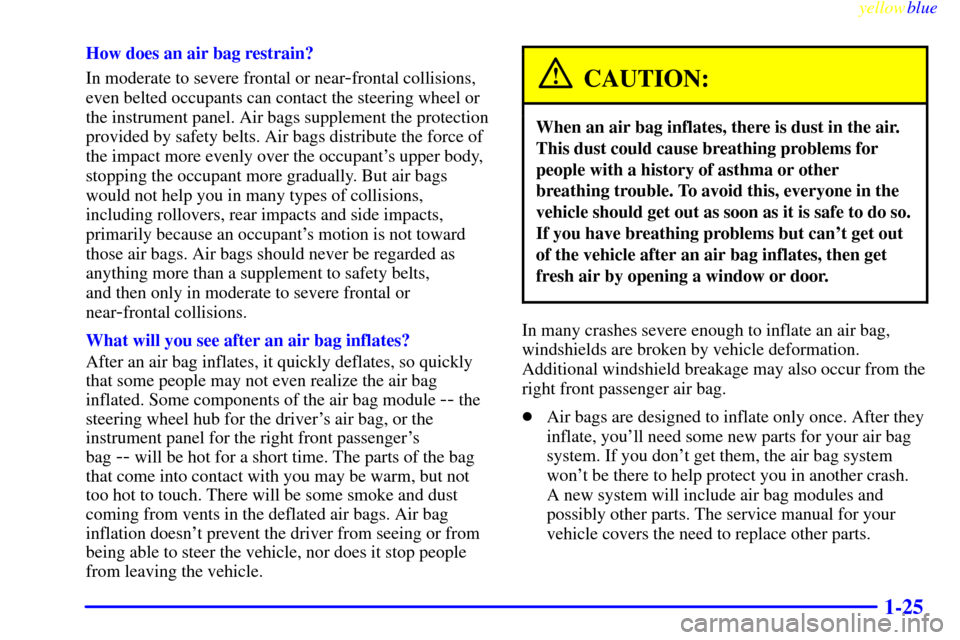Page 3 of 336
yellowblue
iii
The Heritage of Chevrolet
The dynamic William C. ªBillyº
Durant shifted gears from making
carriages to making cars,
forming half the team that gave
birth to Chevrolet.
Louis Chevrolet, the other half of the team,
at the wheel of his experimental ªClassic
Six,º which entered production in 1912.
That year 2999 vehicles were produced.
Welcome to the largest
automotive family in the
world -- the family of Chevrolet
owners. You have selected a
vehicle designed, engineered
and crafted by teamwork, avehicle backed by a proud
history of performance and
value. Since the first ªClassic
Sixº rolled off the line in 1912,
more than 110 million
Chevrolet cars and trucks haveworn the Chevrolet marque.
That kind of reception from
auto owners is unmatched by
any other car manufacturer in
the world.
Page 16 of 336
yellowblue
1-8 Why Safety Belts Work
When you ride in or on anything, you go as fast as
it goes.
Take the simplest vehicle. Suppose it's just a seat
on wheels.
Put someone on it.
Page 31 of 336
yellowblue
1-23 How the Air Bag System Works
Where are the air bags?
The driver's air bag is in the middle of the
steering wheel.
The right front passenger's air bag is in the instrument
panel on the passenger's side.
Page 32 of 336

yellowblue
1-24
CAUTION:
If something is between an occupant and an air
bag, the bag might not inflate properly or it
might force the object into that person. The path
of an inflating air bag must be kept clear. Don't
put anything between an occupant and an air
bag, and don't attach or put anything on the
steering wheel hub or on or near any other air
bag covering.
When should an air bag inflate?
An air bag is designed to inflate in a moderate to severe
frontal or near
-frontal crash. The air bag will inflate
only if the impact speed is above the system's designed
ªthreshold level.º If your vehicle goes straight into a
wall that doesn't move or deform, the threshold level is
about 9 to 14 mph (14 to 23 km/h). The threshold level
can vary, however, with specific vehicle design, so that
it can be somewhat above or below this range. If your
vehicle strikes something that will move or deform, such
as a parked car, the threshold level will be higher. The
air bag is not designed to inflate in rollovers, side
impacts or rear impacts, because inflation would not
help the occupant.In any particular crash, no one can say whether an air
bag should have inflated simply because of the damage
to a vehicle or because of what the repair costs were.
Inflation is determined by the angle of the impact and
how quickly the vehicle slows down in frontal or
near
-frontal impacts.
What makes an air bag inflate?
In an impact of sufficient severity, the air bag sensing
system detects that the vehicle is in a crash. The sensing
system triggers a release of gas from the inflator, which
inflates the air bag. The inflator, air bag and related
hardware are all part of the air bag modules inside the
steering wheel and in the instrument panel in front of the
right front passenger.
Page 33 of 336

yellowblue
1-25
How does an air bag restrain?
In moderate to severe frontal or near
-frontal collisions,
even belted occupants can contact the steering wheel or
the instrument panel. Air bags supplement the protection
provided by safety belts. Air bags distribute the force of
the impact more evenly over the occupant's upper body,
stopping the occupant more gradually. But air bags
would not help you in many types of collisions,
including rollovers, rear impacts and side impacts,
primarily because an occupant's motion is not toward
those air bags. Air bags should never be regarded as
anything more than a supplement to safety belts,
and then only in moderate to severe frontal or
near
-frontal collisions.
What will you see after an air bag inflates?
After an air bag inflates, it quickly deflates, so quickly
that some people may not even realize the air bag
inflated. Some components of the air bag module
-- the
steering wheel hub for the driver's air bag, or the
instrument panel for the right front passenger's
bag
-- will be hot for a short time. The parts of the bag
that come into contact with you may be warm, but not
too hot to touch. There will be some smoke and dust
coming from vents in the deflated air bags. Air bag
inflation doesn't prevent the driver from seeing or from
being able to steer the vehicle, nor does it stop people
from leaving the vehicle.
CAUTION:
When an air bag inflates, there is dust in the air.
This dust could cause breathing problems for
people with a history of asthma or other
breathing trouble. To avoid this, everyone in the
vehicle should get out as soon as it is safe to do so.
If you have breathing problems but can't get out
of the vehicle after an air bag inflates, then get
fresh air by opening a window or door.
In many crashes severe enough to inflate an air bag,
windshields are broken by vehicle deformation.
Additional windshield breakage may also occur from the
right front passenger air bag.
�Air bags are designed to inflate only once. After they
inflate, you'll need some new parts for your air bag
system. If you don't get them, the air bag system
won't be there to help protect you in another crash.
A new system will include air bag modules and
possibly other parts. The service manual for your
vehicle covers the need to replace other parts.
Page 34 of 336

yellowblue
1-26
�Your vehicle is equipped with a crash sensing and
diagnostic module, which records information about
the air bag system. The module records information
about the readiness of the system, when the sensors
are activated and driver's safety belt usage at
deployment.
�Let only qualified technicians work on your air bag
system. Improper service can mean that your air
bag system won't work properly. See your dealer
for service.
NOTICE:
If you damage the covering for the driver's or the
right front passenger's air bag, the bag may not
work properly. You may have to replace the air
bag module in the steering wheel or both the air
bag module and the instrument panel for the
right front passenger's air bag. Do not open or
break the air bag coverings.
If your vehicle ever gets into a lot of water -- such as
water up to the carpeting or higher
-- or if water enters
your vehicle and soaks the carpet, the air bag controller
can be soaked and ruined. If this ever happens, and then
you start your vehicle, the damage could make the air
bags inflate, even if there's no crash. You would have to
replace the air bags as well as the sensors and related
parts. If your vehicle is ever in a flood, or if it's exposed
to water that soaks the carpet, you can avoid needless
repair costs by turning off the vehicle immediately and
disconnecting the battery cables. Don't let anyone start
the vehicle under any circumstances. See your dealer
for service.
Servicing Your Air Bag-Equipped Vehicle
Air bags affect how your vehicle should be serviced.
There are parts of the air bag system in several places
around your vehicle. You don't want the system to
inflate while someone is working on your vehicle. Your
dealer and the Lumina Service Manual have information
about servicing your vehicle and the air bag system. To
purchase a service manual, see ªService and Owner
Publicationsº in the Index.
Page 61 of 336

2-
yellowblue
2-1
Section 2 Features and Controls
Here you can learn about the many standard and optional features on your vehicle, and information on starting,
shifting and braking. Also explained are the instrument panel and the warning systems that tell you if everything is
working properly
-- and what to do if you have a problem.
2
-2 Keys
2
-4 Door Locks
2
-5 Remote Keyless Entry (If Equipped)
2
-9 Trunk
2
-10 Theft
2
-11 Pass-Key� II
2
-13 New Vehicle ªBreak-Inº
2
-13 Ignition Positions
2
-15 Starting Your V6 Engine
2
-17 Engine Coolant Heater (If Equipped)
2
-18 Automatic Transaxle Operation
2
-22 Parking Brake
2
-23 Shifting Into PARK (P)
2
-26 Shifting Out of PARK (P)
2
-27 Parking Over Things That Burn
2
-28 Engine Exhaust
2
-28 Running Your Engine While You're Parked
2
-29 Windows2
-30 Horn
2
-30 Tilt Wheel
2
-31 Turn Signal/Multifunction Lever
2
-36 Exterior Lamps
2
-37 Interior Lamps
2
-39 Mirrors
2
-40 Storage Compartments
2
-42 Ashtrays and Cigarette Lighter
2
-42 Sun Visors
2
-44 Auxiliary Power Connection
2
-45 Sunroof (Option)
2
-45 Cellular Telephone (Option)
2
-45 OnStar� (Option)
2
-46 The Instrument Panel -- Your
Information System
2
-48 Instrument Panel Cluster
2
-51 Warning Lights, Gages and Indicators
Page 70 of 336

yellowblue
2-10 Trunk Lock
To unlock the trunk from the outside, insert the door
key and turn it. You can also use the remote keyless
entry transmitter (if equipped). Just press the trunk
symbol on the transmitter, making sure your shift lever
is in PARK (P).
Remote Trunk Release (Option)
Press the button under the
instrument panel on the
driver's side. Your transaxle
shift lever must be in
PARK (P) for the remote
trunk release button
to work.
Remember, your trunk can be opened at any time using
this lock release, so be sure to lock your doors.
Theft
Vehicle theft is big business, especially in some cities.
Although your vehicle has a number of theft
-deterrent
features, we know that nothing we put on it can make it
impossible to steal. However, there are ways you can help.
Key in the Ignition
If you leave your vehicle with the keys inside, it's an
easy target for joy riders or professional thieves
-- so
don't do it.
When you park your vehicle and open the driver's door,
you'll hear a chime reminding you to remove your key
from the ignition and take it with you. Always do this.
Your steering wheel will be locked, and so will your
ignition and transaxle. And remember to lock the doors.
Parking at Night
Park in a lighted spot, close all windows and lock your
vehicle. Remember to keep your valuables out of sight.
Put them in a storage area, or take them with you.